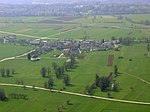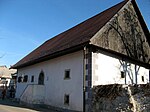Municipality of Žirovnica
1998 establishments in SloveniaMunicipalities of SloveniaMunicipality of ŽirovnicaPages with Slovene IPAWikipedia indefinitely semi-protected pages

The Municipality of Žirovnica (pronounced [ʒiˈɾoːu̯nitsa]; Slovene: Občina Žirovnica) is a municipality in Slovenia. The seat of the municipality is the village of Breznica. In the Završnica Valley, behind the Reber range that overlooks the villages, the first public hydroelectric plant in Slovenia was built in 1914. In 1952, after building a 60 m dam (the highest dam in Slovenia to date) in the Kavčke Gorge, a second hydroelectric plant opened in nearby Moste. This was the first hydroelectric plant to operate on the Sava River.
Excerpt from the Wikipedia article Municipality of Žirovnica (License: CC BY-SA 3.0, Authors, Images).Municipality of Žirovnica
Moste,
Geographical coordinates (GPS) Address Nearby Places Show on map
Geographical coordinates (GPS)
| Latitude | Longitude |
|---|---|
| N 46.4 ° | E 14.133333333333 ° |
Address
Moste
Moste
4274
Slovenia
Open on Google Maps










